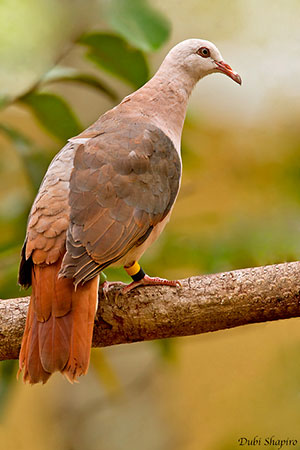
Fr: Pigeon rose
Ang: Pink Pigeon
All: Rosentaube
Esp: Paloma de Mauricio
Ita: Piccione rosa
Nd: Mauritiusduif
Sd: Mauritiusduva
Photographers:
Jean Michel Fenerole
Photos d’Oiseaux du monde
Jean-Claude Jamoulle
A la rencontre des Oiseaux
Dubi Shapiro
Dubi Shapiro Photo Galleries & Dubi Shapiro's Pictures on IBC
Alan & Ann Tate
AA Bird Photography
Text by Nicole Bouglouan
Sources:
HANDBOOK OF THE BIRDS OF THE WORLD vol 4 by Josep del Hoyo-Andrew Elliott-Jordi Sargatal - Lynx Edicions - ISBN: 8487334229
PIGEONS AND DOVES by David Gibbs, Eustace Barnes and John Cox - Pica Press Sussex - ISBN: 1873403607
The Birds of Africa: Volume VIII: The Malagasy Region: Madagascar, Seychelles, Comoros, Mascarenes - Par Roger Safford, Frank Hawkins – ISBN: 1408190494, 9781408190494- Editeur: A&C Black, 2013
Wikipedia, the free encyclopaedia
The Mauritian Wildlife Foundation (MWF)
ZSL - Pink pigeon recovery program
ASAG Species Fact Sheet – Pink Pigeon
Pink Pigeon
Nesoenas mayeri
Columbiformes Order – Columbidae Family
INTRODUCTION:
The Pink Pigeon is endemic to Mauritius where it frequents upland evergreen forests, but it can be seen too in coastal forests with native trees. This arboreal pigeon feeds on numerous plant species from which it consumes buds, flowers, leaves, shoots, seeds and fruits. This species is monogamous and nests in a flimsy platform.
The Pink Pigeon is threatened by destruction and loss of suitable habitat, and by introduced predators. Captive breeding and reintroduction have resulted in some increase of the population, and conservation efforts are still is progress. But the Pink Pigeon is currently classified as Vulnerable.

DESCRIPTION OF THE BIRD:
Biometrics:
Length: 40 cm
Weight: M: 315 g – F: 291 g
The Pink Pigeon has brownish pink upper mantle and narrow brown band across lower mantle. The upper back is darker pink. The rump is pale grey and merges into the chestnut uppertail-coverts. The tail is bright chestnut with pinkish grey outermost rectrices, slightly washed chestnut. The wings are dark brown.
The underparts are pale pink with creamy buff belly.
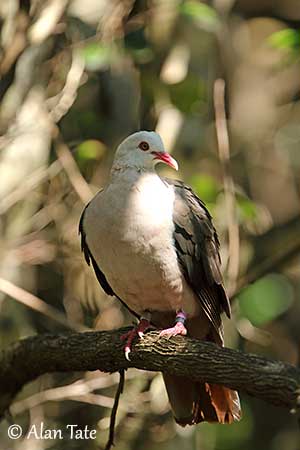
On the head, face and forehead are white. Rest of head and neck are pale pink.
The bill is reddish pink with white tip. The area above the nostrils is deep red. The eyes are whitish to pale yellow, surrounded by conspicuous reddish pink orbital skin. Legs and feet are pinkish red.
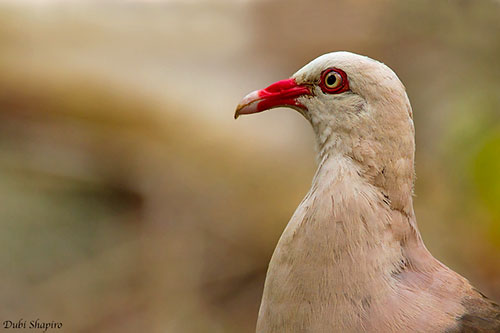
The female resembles male but she is duller with browner rump.
The juvenile is much duller and darker, with buff tips to most wing-coverts. Bill and legs are dark pinkish grey and the eyes are dark brown.
RANGE:
The Pink Pigeon is found on Mauritius Island and the tiny island of Isle aux Aigrettes off the E coast, a predator-free island. It is also found in five other locations belonging to Black River Gorges National Park.
HABITAT:
The Pink Pigeon favours the native evergreen forest with limited exotic plants. It also frequents secondary forest or plantations with adjacent open areas. It is mainly found above 300 metres of elevation where it occurs in low-canopied upland forest, but it was formerly widely distributed over the whole island, including in lowlands.
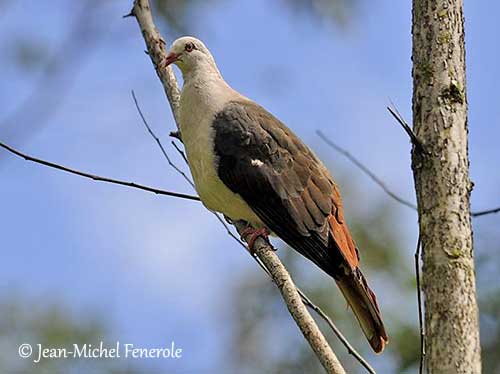
CALLS AND SONGS: SOUNDS BY XENO-CANTO
The Pink Pigeon’s advertising call is a low, monotonous “coo-coo-cooooo-oooo” given from prominent perch within the territory. During courtship, the display call by the male is described as “coo-woo-wah, coo-woo-wah”. We can also hear a deep grunting “wah-wah” given in flight.
The territorial male returning to a perch after some chases and approaching the female, gives an excited cry, a loud, nasal “wa-wah-wahk-wah”. A single, softer note usually follows the copulation.
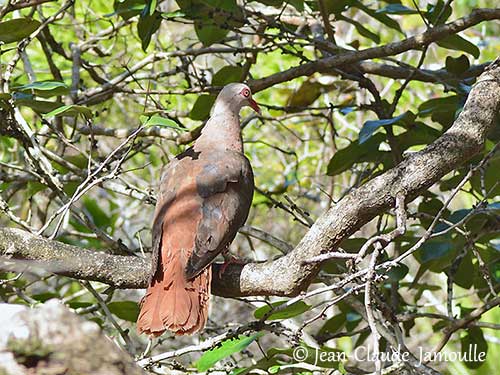
BEHAVIOUR IN THE WILD:
The Pink Pigeon is mainly arboreal and forages in canopy of trees and bushes, and occasionally on the ground.
It feeds on numerous plant species, and it has adapted to food availability according to the season. Its long, slightly hooked bill allows the bird to pluck fruits and flowers off vegetation. It may hang upside down while feeding. Its usual diet includes bugs, flowers, leaves, shoots, seeds and fruits of numerous plant species. On the ground, it searches for seeds and fallen fruits. Some invertebrates are also taken.
This species is provisioned with grains as supplementary food since 1991.
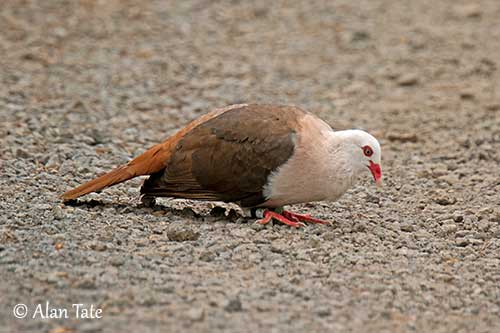
The Pink Pigeon can be seen alone, in pairs or in family groups.
This species is monogamous and territorial. They have long term pair-bonds that end following the death of one or both mates. The territory is advertised by calls and aerial displays typical of Columbidae. The bird flies above the canopy while performing rapid wing-clapping and then, it glides back into the forest with horizontal wings and fanned tail.
Other displays show the male hopping towards the female while bowing regularly with the neck well inflated. Copulation occurs on branch, wire or other available perches.
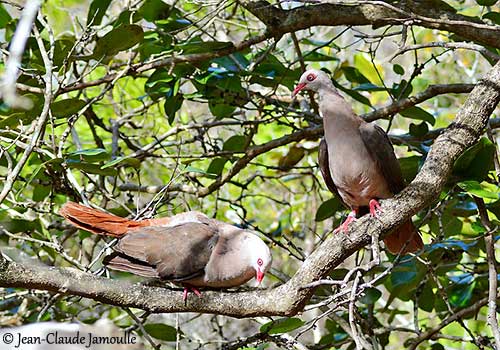
The Pink Pigeon is resident, but it performs trips of 6-8 kilometres from the roosting sites to the foraging areas.
The flight is buoyant, alternating glides with bouts of flapping. It is able to fly slowly and easily within the canopy. The wings usually produce a kind of metallic trumpeting sound during the flight.
REPRODUCTION OF THIS SPECIES:
The Pink Pigeon starts to breed in December, with peak between January and June. The flimsy nest is made with sticks and lined with finer twigs. It is placed between 4 and 15 metres above the ground, often close to the tree trunk and surrounded by dense foliage.
The female lays two white eggs or only one. Both adults incubate during 13-15 days, the male during the day and the female at night and dawn. The chicks are entirely fed on crop milk during the first days, and then, solid food is usually added on 4th day, mainly seeds and tender leaves, and then, flowers and fruits. The young fledge 18-22 days after hatching, but they still depend on parents for food.
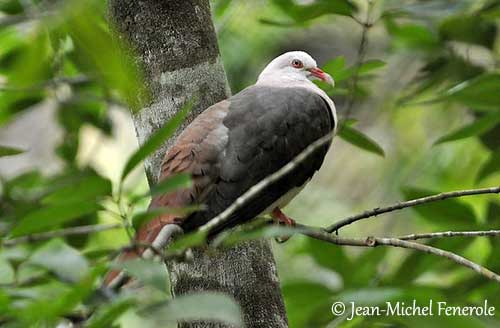
PROTECTION / THREATS / STATUS:
The Pink Pigeon is affected by loss of suitable habitat following forest destruction. The species depends heavily on wheat supplied as supplementary food, due to the lack of availability of native feeding habitat. Competition for food with rats, exotic birds and macaques, and diseases brought to Mauritius by alien pigeons are important problems.
The population was estimated at 77 individuals in 1994, but thanks to captive breeding and reintroduction, conservation efforts and supplementary food, there are more than 300 individuals since 2000. The global population by 2013 was estimated at 370/380 individuals and appears fairly stable since the early 2000s.
But currently, the Pink Pigeon is listed as Vulnerable.
